|
By Walter Sorochan Emeritus Professor San Diego State University Posted July 24, updated May 24, 2019. Disclaimer This article reviews Obamacare and the health-medical care controversy in an unbiased, independent, common sense manner and identifies the shortcomings of Obamacare as cost effective ways to fix the 'health care system'. It covers most of the health-medical care system issues, is researched and written in a simple manner so you, the reader, can understand the health-medical care system issues. Introduction Improving health-medical care is a world wide concern. Gawande: hea care reform 2009 That President Obama is trying to fix our medical care system is not breaking news, for many presidents have unsuccessfully tried to cure the ills. Such failures of the past, to reform a sick medical care system, illustrate the medical care problems and the complexity of such reform. Although the current Obamacare proposal may change with time, this article deals with the current legislation of 2012.
Confusion about Obamacare has cast a controversy over the USA medical care system. Almost everyone agrees that our medical care system is broken and needs to be fixed. But there is disagreement on how to fix the current system. A lot of confusion stems from all the mass media misinformation, the political bias and lack of focus on the really important and relevant issues about health care. Wiki: amacare act 2012 Most of the confusion comes from lack of honest information. The Problem: There is confusion over the terms health care and medical care! Health care is what you provide for yourself: proper diet, exercise, lifestyle, and so forth. Medical care is when you go to the hospital or medical doctor to receive help in times of emergency or acute need. Health care, as used by politicians, is implied to be medical care and refers to Obamacare. This interplay of two different terms greatly adds to the confusion about Obamacare and medical reform. A brief view of the history of medical-health care in United States illustrates that the problems of American medical care system have often been caused by government intervention. Government interventions raise costs higher than they would otherwise be. They do that by artificially stimulating demand and artificially constricting supply. Realizing that the medical care - insurance system of the 1960's was not containing costs, President Lyndon B. Johnson signed amendments to the Social Security Act on July 30, 1965 and created both Medicaid for the poor and Medicare for the elderly. From President Johnson era until 1983, Medicaid and Medicare reimbursed medical care providers on a cost-plus basis, meaning that neither patients nor providers had incentives to keep costs down. On the demand side, the problem was simply this: The government paid for about half the medical care purchased in this country, through the national health [medical] insurance for the poor and elderly known as Medicaid and Medicare. Since Medicaid and Medicare patients pay little or nothing for medical care, they demand more of it than they would otherwise. They have no need to shop for the best value or to be prudent about elective procedures. On the supply side, various governmental regulations enacted at the request of the medical profession have constricted the supply of doctors and other health-care professionals. Medical licensing and the power to accredit medical schools were explicitly motivated by the medical profession's wish to reduce competition and to increase the remaining practitioners' incomes. The delicate balance between the demand and supply medical market sputtered, never controlled the cost of medical care and caused more and more people to be without medical care insurance. As of 2011, nearly 50 million people living in America did not have any medical insurance, and many millions more have inadequate coverage, leaving both their health and financial security highly vulnerable. As currently structured, the American medical care system is all too often inaccessible, unaffordable, inefficient, wasteful, uncoordinated and administratively complex. The time is right for systemic change. Economists argue that since the high cost of medical care is not improving the health of people and the private insurance market is unable to contain costs, that government intervention is justified. Such intervention mechanisms can include anything from a tax to thorough monitoring to other policies. Government interventions trigger the question "What is the role of government in society?" As the reader can surmise, fixing the medical-health care system is complex. It is certainly not transparent! Just who is at fault here? Is it the insurance industry, the government, the health care system, the medical system or the people as consumers? Which are the symptoms and which is the cause? Where does Obamacare fit?
Representing the government are its law makers, the politicians. As everyone is aware, our government has been dysfunctional for quite some time. So a broken health care system may be a symptom of a bigger problem that also needs fixing. The government may be the cause that creates the symptomous health care crises. It is not just Obamacare that will confuse you; it is also the political arguments and mass media reporting that distort the real aspects of medical care. It is the messy details that make you loose your focus! So the first thing we need to do is simplify what Obamacare is and what it will do. President Obama briefly presents his version of Obamacare: President Obama on Obamacare U-Tube 2012: Obamacare is a political term for Patient Protection and Affordable Care Act, [ PPACA ] H.R.3590, passed in 2010. Houchens: Flaws in Obamacare 2012 The Supreme Court of the United States (SCOTUS), on June 28th, 2012, released the ruling on President Obama's health care law and found the law to be largely constitutional with the individual mandate to purchase health insurance being classified as a tax. Nate: Supreme Court decision 2012 Other details of the act are summarized as: Wiki: Obamacare act 2012 Obamacare 2012 Obamacare: Original Bill 2011
The above mandates confirm that Obamacare focuses on bringing medical insurance carriers under control. Houchens: Flaws in Obamacare 2012 Keep in mind that the above information is a summary. The summary assumes that your interpretation of the Obamacare is as intended by the wording of the legal act. Accepting a politician's point of view may be distorting the real truth ... especially when that politician is beholding to vested interest campaign handouts. However, you can view the details of the above summary and get lost and side-tracked in the details: Obamacare: Original Bill 2011 Is Obamacare a good solution? Yes and No! Obamacare is good because it provides universal - catastrophic medical care for everyone. It provides access to medical care for all. Obamacare recognizes the problem as a medical insurance crisis and not as a medical care system crisis. Comparing the large population of United States to other countries [ in the table below ] that have a much smaller population indicates that even countries with a much smaller population pool for insurance have been able to dramatically lower the cost of providing universal health care insurance. So such a comparison points out that other aspects of the medical care system, besides medical insurance, are also causing a crisis and cannot be overlooked! Obamacare is also good because it opens the door to fixing barriers to further medical care system reform. Obamacare is flawed because it will not control expenditures and costs on a long term basis. It probably defers fixing the other big health problems of people. Persons with faulty health habits will continuously get sick and need continuing expensive medical care. This is related to federal spending on treating the sick. Seventy percent of all medical expenditures in the United States are devoted to treating chronic disease; only 4% of the healthcare budget is focused on primary prevention. Cohen: Making health care healthy 2010 Overlooked in Obamacare are health promotional incentives that would be supported by federal and state legislation. As long as government subsidies encourage farmers and health care providers to sell products and commodities that cause consumers to evolve unhealthy lifestyles, that, in turn, make them get sick and evolve chronic diseases, then the care and treatment of such anomalies will lack quality assurance and be out of control. Obamacare focuses on providing symptomatic care for the sick. The real contributing causes of illness and disease, illustrated below, are overlooked!
Roughly 20 percent of patients in the United States have serious chronic illnesses such as diabetes, heart disease, and high blood pressure —-- conditions that in many people can be prevented or controlled with proper nutrition and exercise—and that 20 percent of the diseased persons account for 80 percent of health care spending. O'Brien: overtreatment causing costs Lubitz: Longevity and Medicare expenditures 1995 Obamacare does not look into what are the causes of chronic diseases; it somewhat side-steps dealing with where the spending is greatest. Cohen: Making health care healthy 2010 Another big expense problem lacking a fix are senior citizen health problems. The most expensive age group for health care is senior citizens. Personal health expenditure rises sharply with age within the Medicare population. The oldest group (85+) consumes three times as much health care per person as those 65–74, and twice as much as those 75–84. Alemayehu: Lifetime hea care costs 2004 Instead of taking some personal responsibility for their health and lifestyle choices, they try to rely on medicos to engage in heroic efforts to keep them alive with tubes up their noses after they’ve become flaccid and bloated from a lifetime of bad habits. Although Obamacare provides medical care for the elderly, it does not create economic/social incentives for seniors and their relatives to contain medical costs. It does virtually nothing to encourage and help the elderly promote their own well-being! Overhauling the U.S. medical insurance system, as attempted initially by President Obama, will do absolutely nothing to improve the health of the population. American medicine is extremely good for acute problems and diseases and dealing with emergencies and surgeries, but when it comes to health maintenance [ health promotion ], it’s next to useless. It is also the issues related to the medical-health care system and the role of government in the medical care system that stir the debate about Obamacare. A major issue in medical care reform is the role of government in a society; whether government financed and regulated medical care is better than private funded medical insurance? This issue has been made worse by vested interest politicians protecting their turf or beliefs and forcing their perception of the role of government on the public! Lack of political objectivity and transparency muddies the waters of medical care! Hence utter confusion! So what is the role of government in a society? Government function in society: Simply put, a government should make it possible for everyone, citizens and businesses, to function so everyone in society prospers and stays healthy. The government should provide a floor of opportunity for persons to function, as in the illustration below. The government floor should be limited to provide an equal playing field but not to obstruct or handicap participants. Doing so creates a free enterprise system. This would be an ideal function of government. In the illustration below, the government has overstepped its role by providing a floor that is a muddy and slippery surface and the area for movement is regulated by the ring around the floor. But there are no fight rules about how to fight in the arena. The two combatants, from the private free enterprise sector, are using different rules for fighting. The fighter on the left uses a red glove barrier to gain an advantage while the combatant on the right uses kick boxing. Obviously there is no equal playing field in this illustration. Who is going to create a more equal playing field for both combatants? Who is going to police the boxing event? Should it be the government, the promoters of the boxing event, the combatants themselves or the spectators? Someone needs to referee or monitor the proceedings in the ring.
Does government have a role in a free enterprise system? The obvious answer is yes! The government’s roles would be appropriately limited to those of rule maker, fair referee, enforcer, and safety net of last resort. Hyde: creating hea reform market 2009 Unfortunately, what should be a common sense role is made worse by elected and corrupt elected politicians. "Health is a very political issue in today's world. Politicians talk a lot about improving the healthcare system in their countries. They assume that they know what is a better system. They even assume that they know how to make their system better." Giles: what is good hea care [ healthcare system as used in the above quote is really medical care reform ] Equal playing fields:
What is a good medical care system? A few guiding principles about the best medical care systems: 1. There is no single best medical-health care system in the world Now you and others can disagree on these principles. Doing so is like shopping for an automobile while choking on emitted auto pollution and then buying and driving a polluting car. This shows lack of common sense for expertise knowledge [ such as Gerard Anderson, professor at John Hopkins School of Medicine and a leading expert on international comparisons; and the Lewin Group, prestigious analysts of medical socio-economics, who have shown that changing to the Canadian health-medical care system would save appreciable money ], help balance the federal budget, respect for others having quality of life and so on. The simplest and best indicators of basic performance in terms of health and cost are life expectancy at birth, infant mortality rate and the cost measured relative to national wealth or % GDP. Giles: what is good hea care A good medical care system focuses on two issues: affordable medical care and quality of care for everyone. Cutler: Containing hea care costs 2012 These issues, as just stated and discussed everyday, are ambiguous and will instigate personal viewpoints that end up in controversy. To bring clarity to these issues, we need to define these terms.
What is a single payer system? The video below explains this system:
A single payer system usually requires everyone to buy insurance. Compulsory insurance isn’t exactly a radical concept. Most states require auto insurance because it’s the best way to make people responsible for the damage they can do behind the wheel. But the opposition has turned the battle against the individual mandate into a matter of truth, justice and the unalienable right to not purchase medical insurance and let the taxpayers pick up the free-rider’s emergency room bills. Those against Obamacare also try to discredit the mandate by labeling the mandate as socialism. This is not any more a socialist procedure than requiring auto insurance, that all auto drivers pass a driver's test or legislating that all drinking water be purified. These are ways of protecting the public from being ripped off by no-medical insurance free-riders. Quality of Medical Care: This is also referred to as Quality Assurance. Quality health includes the amount and kind of medical care: primary care, hospital stay, doctor visits, treatment for diseases and disorders, medical care for all aged persons, public health services like sanitation and safe drinking water and so on. In the contentious debate about medical care reform, the U.S. system is often compared to other systems around the world. Some are concerned that the U.S. spends twice as much per person as other rich countries but gets less quality care. Such debates center on whether the benefits should apply to the individual or the good of the mass public. The table below has been simplified from the original number of countries and health indicators. Customized health data 2011 It compares select eight health-medical indicators for USA and 14 other countries. The indicators were selected because they display information that helps to put quality assurance in prospective.
For example, female prevalence of obesity represents lifestyle habits that also reflect on eating habits, cigarette smoking and exercising. Infant Mortality Rate, IMR, in the table tells us that our medical care system is not as good as that of other rich countries. Even the quality of our public health, % of population with access to drinking water and % of population with access to good sanitation, both 99%, is not as good as that of many other countries. We spend more for health per capita, $ 3049, and $45,989 of Gross Development Product or GPD, than many other countries. Our government spends more of total government budget on our medical care system, 19.6%, than most other countries. Our consumers of health, the general public, have bad lifestyles, as reflected in the highest percent of female obesity, 48%, in the world. There are many government laws that allow people to have bad lifestyle habits that contribute to the epidemic of obesity and other illnesses and diseases and the super expensive medical care system to treat the inflicted health problems. The conclusion from the information in this table is that our medical care system is not a good one, it is more expensive than it should be and that our government is not promoting positive lifestyles. It seems that making a profit from sick people is good business! So what is a cost effective medical care system solution for all of United States? As already point, a good medical care system includes affordable medical care and quality of care for everyone. The rest of this article deals with ways of fixing both of these issues. Need a fresh philosophy of medical care: We need to fix what all previous presidents were unable to do and what President Obama is trying to do! We need to fix our dysfunctional government, the broken medical care system and change our philosophy of health-medical care. Buntin: modernizing hea care 2009 The question is which should we fix first? The chicken or the egg?
The intent of medical care opens another issue about providing medical care. Is it to help keep the entire population healthy or make money for for just a few? The current medical model is modeled on profiting off the sick. Obamacare does not address this sensitive issue. Competition in a free market: There have been arguments made that the existing mix of over 400 private medical care insurance companies are a free market system. Also that universal medical care is not a free market system and does not allow supply-demand system to work. This section offers some information on both of these issues. Market failure is at the root of the medical care system’s dysfunction. Kelly: myth of free med market 2011 El-Sayed: Fallacy heacare market Krugman: markets can't cure healthcare 2009 The American Medical Association [AMA] and the federal government, with good intentions to improve the quality of medical care, created an unequal playing field for the medical market as early as 1910. Since 1910, the relationship between providers and consumers gradually drifted into a monopoly non-free medical market that today is manipulated by medical care corporations. Markets work well for goods and services that can be comparison shopped, be easily packaged and sold, which is not the case for health care. Even under competitive conditions, markets may fail to produce socially optimal quantities of a commodity or service. Hence, in the face of these realities it is more appropriate to view medical care differently than a typical consumer product. Karsten: private vs public good 1995 This kind of thinking will no doubt be challenged. Hyde: creating hea reform market 2009 One illusion which exists is that "medical care" can be most efficiently provided by the competitive market. This is hardly the case. Providers of medical care services do not operate like firms in settings of market structures resembling perfect or monopolistic competition. Karsten: private vs public good 1995 Kelly: myth of free med market 2011 El-Sayed: Fallacy heacare market "Health care laws in health [medical] care function differently than in other supply industries. Demand is relatively elastic in response to supply growth and, when patients are insured, is largely price-sensitive. Furthermore, scarcity of price information in the public domain, and information asymmetry with physicians make it difficult for patients to base decisions on value for money. On the supply side, providers of health care largely dictate the quality of services offered, and, given largely elastic and price-insensitive demand, suppliers tend to innovate at the high end of the market rather than introduce innovations that could lower cost." Farrell: accounting for cost of US health care 2008 In 1963, Kenneth Arrow, a Stanford University economist, later a Nobel laureate, decisively demonstrated in a groundbreaking paper that the usual rules of the market can never govern medical care. Arrow: patient health uncertainty & complexity of med services Krugman: markets can't cure healthcare 2009 The subject is the medical-care industry, not health. The causal factors in health are many, and the provision of medical care is only one. Particularly at low levels of income, other commodities such as nutrition, shelter, clothing, and sanitation may be much more significant. It is the complex of services that center about the physician, private and group practice, hospitals, and public. Arrow argued that doctors and patients interact as highly atypical buyers and sellers; thus the price and extent of care provided to the sick should be determined according to standards intrinsic to medicine and not those of business. Since an individual’s health is so variable and largely unpredictable, it should follow that attempting to value and insure it as a commodity, like a car or a house, is antithetical to the practice of medical care and, therefore, is not an appropriate model. Arrow: patient health uncertainty & complexity of med services Conclusion: Based on the current medical care system, even with President Obama's reforms of 2012, there is no free market for medical care. An individual's demand for medical services is that it is not steady in origin as, for example, for food or clothing, but irregular and unpredictable. Illness itself is unpredictable. Medical services, apart from preventive services, afford satisfaction only in the event of illness, a departure from the normal state of free commodity market affairs. Most patients, as consumers of medical care, choose their physicians and not the care they receive. Consumers of medical help have very little knowledge about appropriate medical treatment compared to care providers or the 'real' expertise of the available pool of doctors. This makes it impossible for consumer patients to be able to make good informed decisions about finding low cost and appropriate medical care. With all these unknown circumstances of illness, the patient who may get sick, and the medical care needed, it is impossible to have a free medical market. There is no equal playing field in the Obamacare medical care market --- the medical care market is tilted toward the providers. Budetti: Market justice in US Hea Care 2008 Arrow: patient health uncertainty & complexity of med services Krugman: markets can't cure healthcare 2009 Medical care is not a commodity or product:: Ancient China doctors were paid a fee once a year to keep a family well and actually lost their salaries when the patient got sick. Doctors were not paid when treating sick persons. In the earliest acupuncture text, the Yellow Emperor's Inner Classic, written circa 500 B.C., it is stated that the superior physician prevents the family from getting sick. Ancient Chinese doctors did not make money on sick persons! We need to explore such a medical care system. The philosophy of how we practice medicine and healing is reflected in the cost of medical care and how we manage our medical care system. Health as public good: There is controversy about this concept. Do people prosper as a society, as individuals or both? This is a complex idea. Basically the point being made is that someone has to provide an infrastructure that all members of society use to function as children, adults and entrepreneurs. In economics, a public good is a good that is both non-excludable and non-rivalrous in that individuals cannot be effectively excluded from use and where use by one individual does not reduce availability to others. Wiki: public good Examples of public goods include fresh air, clean water, knowledge, lighthouses, open source software, radio and television broadcasts, roads, street lighting. As Adam Smith, J. B. Say, and others recognized, people are prosperous not as individuals but as members of a prosperous society. Gordon: health care a public good Karsten: private vs public good 1995 A good medical care system can be categorized as a tax supported public good because it provides opportunities for healthy individuals who can use the infrastructure as a place to prosper and do business. The result is that individuals use the conveniences of public goods to prosper, thereby making society more prosperous. The successful Warren Buffets and Bill Gates' of this country are successful because they had access to public infrastructure and also access to healthy consumers of their goods ---- in a healthy environment. Entrepreneurs share the infrastructure --- clean water, roads, education, good food and sanitation much of which has been paid for by public taxes. The bigger issue in medical care that is related to cost of the delivery system is a philosophical one: who should be served by the medical care system: the masses, the healers or the profiteers? This is a philosophical issue and it has been overlooked by Obamacare. The medical care system debate needs to start with some common sense philosophy and not trivial tad-bits! character and health The ancient Greek philosophers would have an entirely different approach to this debate. They would define the terms and seek to find strength in the justice of a medical care system. The Greek Philosopher's Nature of Justice. "The question which opens this immense dialogue is: what is justice? Several inadequate definitions are put forward, but the most emphatically presented definition is given by a young Sophist, Thrasymachus. He defines justice as whatever the strongest decide it is, and that the strong decide that whatever is in their best interest is just. Socrates dismisses this argument by proving that the strong rarely figure out what is in their best interest, and this can't be just since justice is a good thing." For more info: Plato: justice justice Analysis:Plato on justice The realistic approach to medical care has to be a philosophical basis of doing the most good for the most persons. This approach carries more weight and is more important than the minor points in a debate about a good medical care system. Blaming a political system for a failing medical care system, whether it be democracy, socialism or dictatorship, is a moot one. From a Greek point of view, the need is to focus on the country’s civic responsibility for its people. The state’s responsibility to its populace is similar to that of a parent to its children. Is taking care of a family’s children any different than a government taking care of it’s people? The state, like a parent, has a parallel obligation to protect the health of its citizens. Now let us put the shoe on the other foot: Should a citizen have the right to expect good medical care from society? Does a worker need good health to be productive? Does a country benefit from a healthy citizenry? What are the justifications for such expectations? The ancient Greeks would love this part of the debate! So what is the real incentive for a country to maintain a healthy society? The answer is very simple: Healthy workers produce more goods for a longer time, pay taxes and in turn, have money to buy the necessities of life and bolster a healthy national economy. The Gross Developmental Product [ GDP ], a measure of the wealth of a country, goes up. Another ethical question needs to be discussed: Is it proper or just for a medical care provider to profit from serving a sick or dying person? Is doing so any different from a funeral director selling a funeral casket to a distraught and mourning relative of a dead person, thereby taking advantage of the relative’s emotionally vulnerable status? A sick person grasps for straws while struggling to make informed decisions and stay alive. Where is the justice in profiting from a sick person? Is it just to ignore giving health care when the sick person cannot pay for it; thereby perhaps infecting others with his/her malady? Obamacare temporarily overlooks the issue of whether it is just to make money from sick persons! Obamacare assumes that people will prosper as a society from better health care. Find causes of health problems: We need to really focus on identifying the causes of our problems and less so on the symptoms! Our doctors relieve symptoms by prescribing medication for most of our health problems. This does not fix the medical problems; instead it is driving health costs up.
Medical schools and the AMA have created monopoly --- a lop-sided medical market in favor of providers. For example, the restrictions on entry to medical schools is itself not part of a free market supply-demand system. The high cost of medical education in the United States is itself a reflection of the quality standards imposed by the American Medical Association since the Flexner Report. This has resulted in a high cost of medical education that has been subsidized and both the quality and the quantity of the supply of medical care have been strongly influenced by this none free market. Arrow: patient health uncertainty & complexity of med services Medical schools and the AMA have both imposed licensing laws and standards on medical-school training that limit the possibilities of alternative qualities of medical care and the number of practitioners. Theoretically, a supply of more doctors would increase the pool of available doctors competing for medical care jobs and thereby lower the cost of physician care services. But this is not the case in United States. Indeed, medical schools also control the number of students allowed to enter medical schools so graduate MDs can get high salaries. These type of restrictions do not meet the criteria of a free supply-demand medical market system. Obamacare deferred reforming this aspect of medical care at this time. Some aspects of the medical curriculum itself are questionable, like the glaring lack of legitimate courses on nutrition. Most of today's medical practitioners did not take a 'real' nutrition class as a medical requirement to get a medical degree, Huff: MDs lack nutrition 2012 yet display their ignorance about vitamins and minerals in attempting to advise their patients on nutrition and health. Knowing medicine is not the same as knowing about health! Many patients know more about nutrition than their doctors. Obamacare overlooks this reform at this time.
In an attempt to control costs, managed-care organizations have attempted to measure the process of medical-care delivery, rather than identifying physicians who keep their patients healthy. Managed care has failed to contain costs or improve doctor care. Doctors need to focus less on defensive practice and more on making the patient well. e.g. Doctors also need to change the small habits of how they practice medicine ---- by minimizing patient waiting time to see a doctor and sharing information directly with patients via e-mails. Doctors need to do a better job of monitoring their patients that are prescribed medications. Young: 100,000 die from drug Perdomo: Durgs kill 100,000 each year
Submissions to the US Food and Drug Administration (FDA) may be worse than in other countries, since the agency doesn’t actually require any data. Their policy says that biotech companies can determine if their own foods are safe. Anything submitted is voluntary and, according to former Environmental Protection Agency scientist Doug Gurian-Sherman, PhD, “often lack[s] sufficient detail, such as necessary statistical analyses needed for an adequate safety evaluation.” Health risks of genetically modified foods Obama needs to overhaul how the FDA selects persons with no vested drug interests and how the FDA works! Rodreguez: FDA is broken 2011
Need real research on consumer health and not drugs: Much of the research done at universities and funded by the federal government is questionable research. Moorel: value of research It subsidizes university professor's salaries, discovers little useful information and seldom benefits society. We need more research on how healthy bodies should work. We need to do more preventive research that is useful for patient-consumers. Rothbard: Gov med insurance 2012 Obamacare needs to redirect research funding. The U.S. is the world’s leader in medical innovation because our government pumps tens of billions of dollars into health research each year through the National Institutes of Health [ NIH ]. In fact, many of the drugs, medical devices, and clinical tests that ultimately get marketed and sold by private sector medical companies originated in NIH-funded labs across the country. El-Sayed: Fallacy heacare market But the funding for products that cannot be patented and copyrighted, like vitamin and mineral supplements, and how nutritional co-factors work, get almost no funding. Drug companies have a huge influence over what gets researched, how it is researched, how the results are reported, how they are analyzed, and how they are interpreted. NBCNews: FDA conflict of interests 2008 Obamacare needs to take drug research out of the hands of drug corporations. We need to focus more on funding independent research, outside the realm of drug corporations, to find out how the very young and the elderly can take better care of themselves, with a minimum of help from the health care system; thereby reducing dependence on the medical care system. Perhaps the most significant need is for someone finding the time and funding to research on how benefits from common everyday lifestyle affect health; like how foods and proper eating habits may more effectively enhance the individual biochemistry of individuals than medications. Such focus needs government reinforcement for health promotion as well. Medicine knows very little about maximizing the nutritional well-being of all age groups. Dealing with the terminal last days of life:
Update water treatment facilities:
Chlorine was chosen in the early 1900 as the best way at that time to purify water for drinking purposes. As with many novel chemical innovations, however, what was once thought perfectly harmless has turned out to be poisonous. Over the past 25 years, scientists have discovered that while chlorine is killing microbes, it is also reacting with organic matter already in the water to form toxic chemicals called organochlorines [ also known as disinfection by-products or DBPs ]. To date, several hundred known organochlorines have been found in drinking water but many times that number are chemically unidentified. Federal government monitoring programs show that many U.S. cities have elevated levels of organochlorines at the tap--concentrations substantially higher than most public water systems. This is especially disconcerting because numerous of these organochlorines [ DBPs ] are known carcinogens and mutagens. Epidemiological research by Morris has directly linked chlorinated drinking water to cancer and possibly miscarriages. Fleckenstein: unsafe drinking water 2001 Although chlorine kills all germs, it is a poison to our bodies. Chlorine is a goitrogen ---- it interferes with iodine absorption in the body. Iodine is an essential nutrient for not just the thyroid gland but every cell on the body. Chlorine, as well as fluoride [ added to drinking water to prevent dental caries ] and bromide [ used as herbicide ] easily interfere with iodine absorption. When iodine is replaced by the more active halogens, the body absorbs less iodine and the population is then at increased risk to goiter and other diseases and disorders --- including silent health problems. Abraham: Orthiodinesupplementation Drinking Water Chlorination Finally, the U.S. General Accounting Office reports that there are serious deficiencies in water treatment plants in 75% of the states. According to a study conducted by the Natural Resources Defense Council, more than 120 million people may get unsafe drinking water. Pure eEarth technologies Several alternatives to traditional chlorination exist, and are being used today in many countries. Ozonation is used by many European countries and also in a few municipalities in the United States. Due to current regulations, systems employing ozonation in the United States still must maintain chlorine residuals comparable to systems without ozonation. Wiki: chlorination Municipal water treatment plants are part of our deteriorating infrastructure. Our people cannot live without a supply of safe drinking water. Obamacare has postponed fixing the outdated public water system that may be contributing to illnesses and diseases. REDUCING ADMINISTRATIVE COSTS Spending on administration is much higher in the United States than in other countries, and is much greater than any analyst suggests is needed. For every office based physician in the United States, there are 2.2 administrative workers; in Canada, there are half as many. U.S. hospitals have 1.5 administrative workers per bed; that is 40 percent more than in Canada. Cutler: Containing hea care costs 2012 Our medical care system is driven by a profit motive rather than a focus on helping people get well and stay well. Independent journalists recently compared the number of staff in the billing department of a hospital in Massachusetts and another in Toronto, Canada. The US hospital had 300; the Canadian facility had just three. Changing the idea of making money from medical care to helping people stay well would cut administrative costs! Alberti: Admin price differences 2012
Regulating medical care providers to control health care costs: Medical care providers should be more realistically viewed as enterprises which exercise "monopoly power." Today insurance and drug corporations not only buy politicians with their campaign monies and lobbying influences, they are also in a position to significantly influence supply and demand conditions, pricing and output decisions, excess profits, and also tend to generate inefficiencies. These entities disrupt an equal playing field for consumers! Consumer Reports estimates that "roughly 20 percent of the money we now spend could be saved with no loss in quality of care" and also save about 50 percent of administrative costs. Karsten: private vs public good 1995 The General Accounting Office found that those prescription drugs that were marketed and made in the U.S. but also marketed in Great Britain, tended to carry a 60 percent higher price tag, on the average, in the U.S., with some drugs selling at five, or even eighteen times the prices charged in England. Karsten: private vs public good 1995 How much profit should private insurance companies make? According to a study by a pro-medical reform group, the nation's largest five medical insurance companies posted a 56 percent gain in 2009 profits over 2008. The insurers [ Wellpoint, UnitedHealth, Cigna, Aetna and Humana ] cover the majority of Americans with medical insurance; not health care which is health promotion. Wiki: Hea insur in USA This excessive amount of profit, when compared to less than 10% profit that other businesses expect in order to stay in business, is a good reason to bring private medical insurance companies under control! Thank President Obama for doing just that! Paying for health care: All the above issues would be incomplete with addressing how medical care should be paid for. Obamacare inherited a dysfunctional insurance system, and stumbles in a mix of insurance sponsored schemes that contribute to confusion, controversy and continued expensive coverage. The implementation of employer sponsored insurance happened more or less by accident, without good planning nor design. Jaslow: employer-sponsored health insurance 2011 The system of employer-sponsored insurance is not well designed to deal with the problems of the costs and quality of medical care in the United States. Blumenthal: Employer-Sponsored Insurance This is a complex issue and we need to briefly review how we pay for medical insurance. Employer-sponsored medical insurance is paid for by businesses on behalf of their employees as part of an employee benefit package. Most private (non-government) medical coverage in the US is employment-based. Nearly all large employers in America have been forced to offer group medical insurance to their employees. Typically, employers pay about 85% of the insurance premium for their employees, and about 75% of the premium for their employees' dependents. The employee pays the remaining fraction of the premium, usually with pre-tax/tax-exempt earnings. Wiki: Hea insur in USA According to a 2007 study, about 59% of employers at small firms (3-199 workers) in the US provide employee medical insurance. Most of the businesses employ fewer than 50 persons and the initial plan had difficulties covering such wage earners. Also this plan did not provide medical insurance to those who were not working. In spite of all the legal adjustments to make this plan work, it sputters today. Wiki: Hea insur in USA Effective by January 1, 2014, the Patient Protection and Affordable Care Act will impose a $2000 per employee tax penalty on employers with over 50 employees who do not offer medical insurance to their full-time workers. In 2008, over 95% of employers with at least 50 employees offered medical insurance. Wiki: Hea insur in USA Buchmueller and Monheit studied the “goodness of fit” of Employer Sponsored Insurance [ ESI ] in the current economic and medical insurance environments. Their findings: Buchmueller: Health insur reform 2009
Although Obamacare attempts to avoid "rocking the boat" and continue using the mix of existing employer insurance systems, the problems of such a convoluted way to provide medical insurance coverage will continue. There is doubt that employer insurance systems will survive and may even reduce costs of medical care. Blumenthal: Employer-Sponsored Insurance Kelton: Hea care crisis 2007 The major problem of employer based medical insurance that is overlooked is that the employers pass on the cost of medical insurance to the products they make. This makes their products less competitive on the global market.
National medical insurance dramatically lowers costs of medical care and in turn, allows US businesses to be more competitive in the global market. Adopt from other systems: Although there is no single best medical care system in the world today, some systems work better than others and these are cost effective. We can learn from rich [ Canada, Germany, Switzerland ] and poor countries on how to best reform the medical care system. Contrary to common perceptions, the German health insurance system, "is not government run, in either its financing or its delivery." "The government prescribes policy but private parties finance and deliver services." It functions "to mandate, specify, authorize, referee, consult, collaborate, regulate, monitor, and supervise." Karsten: private vs public good 1995 Summary on reforming the medical care system: There is no shortage of ideas about fixing the medical care system. NMSS: Health care reform principles Barron: medical failures 2008 Farrell: accounting for cost of US health care 2008 By now you, the reader, have your own suggestions about fixing our broken medical care system. The cartoon below also has a suggestion!
Almost every president since President Roosevelt in the early 1930's has failed to provide medical care legislation. We need to commend President Obama for attempting to do the impossible with a dysfunctional congress and senate. Although Obamacare has many empty holes in it, getting everyone insured would be a gigantic step toward a sustainable health care system. It should be evident by now that the majority of people have bad behaviors and habits and lack the acumen to make wise choices. Our American culture has spawned a disease culture. To view 10 things medical doctors must do to reform medical care go to: Barron: medical failures 2008 There will be no real success in real medical care reform until the political system is reformed and congress and senate begin to function on behalf of the people. Government’s “reforming medical insurance for all or Obamacare” before fixing the dysfunctional congress and senate is putting the cart before the horse. References: Abraham Guy. E. M.D., Jorge D. Flechas M.D. and John C. Hakala R.Ph., "Orthoiodosupplementation: Iodine Sufficiency Of The Whole Human Body," Abraham: Orthiodinesupplementation Agency for Healthcare Research & Quality, "The High Concentration of U.S. Health Care Expenditures," AHRQ, June 2006, Pub. No. 06-0060. AHRQ: hea car expenses 2006 Mark W. Stanton, "The High Concentration of U.S. Health Care Expenditures," AHRQ, Research in Action, Issue 19, 2006. Stanton: hea care expenses 2006 Alberti Mike, "Health insurance maze a major financial burden on hospitals, doctors, businesses," Remaping Debate, June 20, 2012. Alberti: Admin price differences 2012 Alemayehu Berhanu and Kenneth E Warner, "The Lifetime Distribution of Health Care Costs," Health Serv Res. 2004 June; 39(3): 627–642. Alemayehu: Lifetime hea care costs 2004 The distribution of health care costs is strongly age dependent, a phenomenon that takes on increasing relevance as the baby boom generation ages. After the first year of life, health care costs are lowest for children, rise slowly throughout adult life, and increase exponentially after age 50 (Meerding et al. 1998). Bradford and Max (1996) determined that annual costs for the elderly are approximately four to five times those of people in their early teens. Personal health expenditure also rises sharply with age within the Medicare population. The oldest group (85+) consumes three times as much health care per person as those 65–74, and twice as much as those 75–84 (Fuchs 1998). Nursing home and short-stay hospital use also increases with age, especially for older adults (Liang et al. 1996). Arrow KJ., "Uncertainty and the welfare economics of medical care," The American Economic Review. December, 1963, 53:5. Arrow: patient health uncertainty & complexity of med services Auerbach D. I. and A. L. Kellermann, “A Decade of Health Care Cost Growth Has Wiped Out Real Income Gains for an Average US Family,” Health Affairs, Vol. 30, No. 9, September 2011. $ 17, 040 Auerbach: Heacare costs per family 2011 Barron Jon, "World's Greatest Medical Failures," The Baseline of Health Foundation, July 21. 2008. Barron: medical failures 2008 Blackwell Syd, "Health Care in Uruguay… An OU Quick Guide," OFA Uruguay, November 10, 2010. Blackwell: Hea Care Uruguay 2010 Blumenthal David, "Employer-Sponsored Insurance — Riding the Health Care Tiger," NEJM, july 13, 2006. Blumenthal: Employer-Sponsored Insurance Buchmueller Thomas C. and Alan C. Monheit, "Employer-aponsored health insurance and the promise of health insurance reform," National Bureau of Economic Research, April 2009. Buchmueller: Health insur reform 2009 Budetti Peter P., "Market Justice and US Health Care," JAMA, January 2, 2008—Vol 299, No. 1. Budetti: Market justice in US Hea Care 2008 Buntin Melinda Beeuwkes and David Cutler, "The Two Trillion Dollar Solution Saving money by modernizing the health care system," Center for American progress, June 2009. Buntin: modernizing hea care 2009 Chodorov Frank, "Economics versus Politics," Mises Daily, April 03, 2007. : From The Rise and Fall of Society, 1957; Chodorov: Economics vs politics Chodorov: Mises Daily quotes "Economics is not politics. One is a science, concerned with the immutable and constant laws of nature that determine the production and distribution of wealth; the other is the art of ruling. One is amoral, the other is moral. Economic laws are self-operating and carry their own sanctions, as do all natural laws, while politics deals with man-made and man-manipulated conventions. As a science, economics seeks understanding of invariable principles; politics is ephemeral, its subject matter being the day-to-day relations of associated men. Economics, like chemistry, has nothing to do with politics." Code Blue Now, "Comparison of Health Care Systems." CodeBlue: Comparison of Health Care Systems Cohen Gary, "Making health care healthy," Social Entrepreneurs What Matters, April 6, 2010. Cohen: Making health care healthy 2010 Seventy percent of all health expenditures in the United States are devoted to treating chronic disease; only 4% of the healthcare budget is focused on primary prevention. Cutler David M., "TESTIMONY OF DAVID M. CUTLER Before the Committee on the Budget United States Senate," February 29, 2012. Otto Eckstein Professor of Applied Economics, Harvard University Cutler: Containing hea care costs 2012 Daley Alex and Doug Hornig, "How health care can cost so much, despite technology," Casey Research, July 12, 2012. Daley:longer living costs more 2012 Docteur Elizabeth and Robert A. Berenson, "How Does the Quality of U.S. Health Care Compare Internationally?," Timely Analysis of Immediate Health Policy Issues 11, August 2009. Docteur: US hea Care compaision others 2009 Edmonds Molly, "10 Health Care Systems Around the World," How Stuff Works. Edmonds: hea care around world El-Sayed Abdulrahman, "The Fallacy of Free Market Healthcare," Politics, Health Care." El-Sayed: Fallacy heacare market Farrell, Diane, Erric Jensen, Bob Kocher, Nick Lovegrove, Fareed Melhem, Lenny Mendonca and Beth Parish, "Accounting for the cost of US health care: A look at why Americans spend more," McKinsey Global Institute, December, 2008. Farrell: accounting for cost of US health care 2008 Fleckenstein Paul, "Cancer on tap: The risks of chlorinated drinking water," GreenSense, May 18, 2001 Fleckenstein: unsafe drinking water 2001 Free rider (or freeloader) is someone who enjoys the benefits of an activity without paying for it. The free rider may withhold effort or resources, or may impose the costs of his or her activities on others. Free-riders in health care are those persons don't have health care insurance but use emergency hospital medical services when they are sick. They pass their medical costs on to others. Hospitals and government programs pay for their medical expenses; thereby increasing the cost of health care to others. Many free riders in society wait until they get sick to buy insurance. “Free-rider” has a romantic feel to it. He rides through the West on his Harley, fearless and free, unconcerned about the cost of putting him back together when his Harley meets a tree." Read more Frontline, "Sick around the world - Five capitalist democracies & how they do it," April 15, 2008. Frontline: how 5 countries do it 2008 Gawande Atul, "Getting There from Here - How should Obama reform health care?" The New Yorker, January 26, 2009. Gawande: hea care reform 2009 Giles Allen, "What makes a good healthcare system?: comparisons, values, drivers," Radcliff Medical Press, United Kingdom, 2003. Giles: what is good hea care Gordon Geoffry B., "Is health care a public good?" MedpageToday KevinMD.com. Gordon: health care a public good Guttman Nathan and Nathan Jeffay, "Israel's Health Care Outpaces U.S.," The Jewish Daily, Published June 28, 2012, issue of July 06, 2012. Guttman: Isreal-US compared 2012 Houchens Paul R., "Measuring the strength of the individual mandate," Millman Research Report, March, 2012. Houchens: Flaws in Obamacare 2012 Hyde Stephen, "The proper role of government in health care reform -- Part I: Market failure," Hyde on Health Care, November 12, 2009. Hyde: govt role in health care 2009 "Health care constitutes a massive opportunity for an enlightened government regulatory role that will allow markets to cure all its problems of cost, quality, and access. Currently, health care is the only one of our five fundamental human needs not being met by well-functioning markets (the other needs are food, clothing, housing, and transportation). Yet health care, like the others, is what economists call an economic good, having both the scarcity and the discernible prices that normally allow markets to self-develop to become the optimal medium of production and distribution. "Health insurance works according to the Pareto Principle, more commonly known as the 80/20 rule. At any given time, about 20% of the people consume 80% of the medical care. Thus, an insurer’s customers must include 80% who are healthy in order to assure payment for the 20% who aren’t. Imagine an intellectually-challenged entrepreneur who opens a comprehensive, 24/7 health insurance supermarket that works like a food market or a clothing store. Any customer can walk in, take an insurance policy off the shelf, and pay for it at checkout. But who will actually shop in this supermarket? Right, sick people. Healthy people will stay away until they get sick, thus depriving the entrepreneur of the healthy 80% necessary to pay the bills. An economist might say that, because this adverse selection causes one person’s decision to purchase (or not) health insurance to increase another person’s price for it, there is a negative externality that results in a Pareto sub-optimal allocation of resources, or more simply, a market failure. Or, as the unfortunate entrepreneur might put it, “My God, I’ve gone broke!” "Although such insurance supermarkets can’t work, wiser entrepreneurs figured out a long time ago that there are two—and only two—natural markets for health insurance: large employer groups and healthy individuals. Large employer groups are inherently insurable because they fit the 80/20 rule (and not because of a WWII tax ruling that excluded employer-provided health benefits from federal taxes). That’s also true for healthy individuals, as long as the insurer is allowed to confirm their healthy status before agreeing to insure them. Unfortunately, however, there are no natural health insurance markets for the elderly, the disabled, the poor, or for sick individuals. This is the result of the above-described health-insurance market failure that no “free” market will ever correct. Why is health care the exception? Free-market advocates claim it’s because of decades of government interference with programs like Medicare, Medicaid, and SCHIP that prevent markets from functioning properly. But that’s not the reason. Those programs are simply a response—a poor response to be sure—to a fundamental market failure arising from the fact that no natural, self-organizing market will ever provide the necessary health insurance that everyone needs for protection against the risks of unaffordable, necessary medical care." Hyde Stephen, "The proper role of government in health care reform -- Part 2: CREATING A HEALTH CARE MARKET, Hyde on HealthCare, November 18, 2009. HHyde: creating hea reform market 2009 Huff Ethan A., "Doctor admits that most MDs know nothing about nutrition, health," Natural News, October 04, 2010. Huff: MDs lack nutrition 2012 Jaslow Ryan, "Is employer-sponsored health insurance on life support?" Health Pop, August 24, 2011. Jaslow: employer-sponsored health insurance 2011 Kaiser Family Foundation, "US Global Health Policy, Customized Data Sheet," Customized health data 2011& Karger Jim, "American Medical Care Is Terminal," Whiskey and Gunpowder, July 5, 2012. Karger: Medicare is terminal Karsten Siegfried G., "Health care: private good vs. public good," American Journal of Economics and Sociology, April, 1995. Karsten: private vs public good 1995 Kelly Kel, "The Myth of Free-Market Healthcare," Mises Daily, March 09, 2011. Kelly: myth of free med market 2011 Kenfield Isabella, "Monsanto's Man in the Obama Administration - The Return of Michael Taylor," CounterPunch, August 18, 2009. Kenfield: Michael Taylor revolving door 2009 "The Vice President for Public Policy at Monsanto Corp. from 1998 until 2001, Taylor exemplifies the revolving door between the food industry and the government agencies that regulate it. He is reviled for shaping and implementing the government’s favorable agricultural biotechnology policies during the Clinton administration."Kelton Stephanie, "An Introduction to the Health Care Crisis in America: How Did We Get Here?" Center for Full Employment and Price Stability (CFEPS), September 2007. Kelton: Hea care crisis 2007 Krugman Paul, "Why markets can’t cure healthcare," The New York Times, July 25, 2009. Krugman: markets can't cure healthcare 2009 Lubitz J, Beebe J, Baker C., "Longevity and Medicare expenditures," N Engl J Med. 1995 Apr 13;332(15):999-1003. Lubitz: Longevity and Medicare expenditures 1995 Mayer David, "The Need for Medical School Curriculum Overhaul," Florida International University, July 9, 2012 Meyer: overhaul med curriculum 2012 McVay Douglas A., , "Annual Causes of Death in the United States." Drug war facts. McVay: drug war causes Drug War Facts is sponsored by Common Sense for Drug Policy. Miller Talea, "Comparing International Health Care Systems," PBS NewsHour, October 6, 2009. Miller: Int Hea Care Systems 2006 Moore1 Gary E., "Significance" of Research in Vocational Education," Journal of Vocational Education Research, Vol. 17, No. 4, 1992. Moorel: value of research National Healthcare Single -Payer Association, "What is Single-Payer Healthcare?" Single Payer System National Multiple Sclerosis Society, "Health care reform principles," NMSS: Health care reform principles National Health Care Reform Principles: NBC News, "FDA drug panels rife with conflicts of interest: Study finds money influences federal experts' decisions on medications," April 26, 2006. NBCNews: FDA conflict of interests 2008 Obama Barack, "Obamacare: Delivering affordable health care," Jun 29, 2012. Obamacare: U-tube 2012 O'Brien Sharon, "Baby Boomers Not to Blame for Rising Health Care Costs," Senior Living. O'Brien: overtreatment causing costs Overtreatment and chronic illness are leading factors in high health care costs Owen David G., "Dangers in Prescription Drugs: Filling a Private Law Gap in the Healthcare Debate," CONNECTICUT LAW REVIEW, February 2010, VOLUME 42 FEBRUARY 2010 NUMBER 3, University of Connecticut School of Law, Owen: Dangers in Prescription Drugs & legality "Once information on these side-effects (of drugs) became known to the public, the manufacturers of each of these drugs stopped selling them and, eventually, paid millions or billions of dollars to settle claims for resulting injuries.10 Merck, for example, having withdrawn the profitable Vioxx drug11 from the market in 2004, settled nearly 50,000 Vioxx cases in late 2007 for $4.85 billion.12 In 2009, Eli Lilly agreed to plead guilty and pay $1.415 billion in criminal and civil penalties for promoting its antipsychotic drug, Zyprexa, as suitable for uses not approved by the Food and Drug Administration (“FDA”).13 These cases may be among the more prominent, but they represent just the tip of the iceberg of damage caused by prescription drugs."" Nate, "Supreme Court upholds ObamaCare mandate as a "tax" in 5-4 decision," 2012 Election central, June 28th, 2012. Nate: Supreme Court decision 2012 Obamacare, "Bill Summary & Status 111th Congress (2009 - 2010) H.R.3590 All Information," The Library of Congress Thomas Obamacare: Original Bill 2011 Obamacare, "Patient Protection and Affordable Care Act 2010 --- Basic Requirements," 2012. Obamacare 2012 OECD, "Health at a Glance 2011 - OECD Indicators." November 23, 2011 OECD: health indicators "The Organization for Economic Cooperation and Development (OECD) tracks and reports annually on more than 1,200 health system measures across 30 industrialized countries, ranging from population health status and nonmedical determinants of health to health care resources and utilization." PBS Newshour, "Comparing International Health Care Systems," October 6, 2009. PBS: hea sys comps 2006 Perdomo Daniela, "100,000 Americans Die Each Year from Prescription Drugs, While Pharma Companies Get Rich," Alter Net, June 25, 2010. Perdomo: Durgs kill 100,000 each year
Private vs public goods: Private goods may be defined as those which carry a price, which can be easily withheld from those who are unwilling or unable to pay for them (exclusion property), and whose benefits are rival in consumption to those of other goods. While health insurance may fit this simplistic definition of a private good, the commodity "health care" does not. For one, it cannot be easily packaged and marketed as is the case with an ordinary consumer good. Even were this feasible, it would be considered to be "unethical." Second, the benefits derived from "health care" do not rival those of another commodity, such as between buying a TV or a stereo set. Third, the exclusion principle is not fully applicable to health care. Karsten: private vs public good 1995 In contrast, a public good is usually defined as one which is available for consumption to anyone regardless of whether or not one is able to pay for it. Once it is produced, it is not subject to the exclusion principle. It is also assumed that the additional cost of providing another unit is at least negligible. Again, health care does not fit this simplistic definition of a public good either. Morally, or legally, health care may not be denied to an individual who is seriously ill, but mostly in emergency rooms. Karsten: private vs public good 1995 Quality assurance is the process of measuring performance against a defined standard and seeing how it compares. Reid T.R., "Does universal coverage mean socialized medicine?" Frontline, April 15, 2008. Reid: socialized medicine Rodreguez Juan, "Juan Enriquez Eviscerates the FDA," Central Science, December 6th, 2011. Rodreguez: FDA is broken 2011 Rothbard Murray N., "Government Medical "Insurance," Mises Daily, June 29, 2012. Rothbard: Gov med insurance 2012 Roy Avik, "Why Switzerland has the world's best health care system," Forbes, April 29, 2011. Avik: Switz best health care 2011 Roy Avik, "Obamacare's Dark Secret: The Individual Mandate is Too Weak," Forbes, July 09, 2012. Roy: Obamacare flaws 2012Soderlund Neil, James Kent, Peter Lawyer, and Stefan Larsson, "Progress Toward Value-Based Health Care Lessons from 12 Countries," Boston Consulting Group, June 06, 2012. Soderland: value based hea care 2012 Squires David A., "The U.S. Health System in Perspective: A Comparison of Twelve Industrialized Nations, Issues in International Health Policy, July 2011. Squires: 12 countries compared 2011 Steinreich Dale, "100 Years of Medical Robbery," Mises Daily: Thursday, June 10, 2004. Steinreich: brief history govt intervention 2004 Adopted from Dale Stein, "100 Years of US Medical Fascism," Mises Daily, April 16, 2010. Stein: 100 years of US heacare 2010 Taiwan Government, "Public Health," Government Information Office, 2005. Taiwan: Public health 2006 Tanner Michael D., "Bad medicine A guide to the costs and consequences of the new health care law," Cato Institute, 2011. Tanner: bad law 2011 Terhune Chad, "Average annual healthcare cost for a family tops $20,000," Los Angeles Times, May 15, 2012 Terhune: Hea Care costs equal new car 2012 Universal health care is determined by three critical dimensions: who is covered, what services are covered, and how much of the cost is covered. WHO, "World Health Statistics 2012 - Part III Global health indicators." WHO: health indicators 2012Wikipedia, "Electronic Medical Records." Wiki: EMR Wikipedia, "Health care reform debate in United States." July 9, 2012. Wiki: hea care debate 2012 Wikipedia, "Health care reform in the United States." July 8, 2012. Wiki: Hea care reform in USA Wikipedia, "Health insurance in the United States." Wiki: Hea insur in USA Wikipedia, "Patient Protection and Affordable Care Act." July 9, 2012. Wiki: Obamacare act 2012 Wikipedia, "Public good," Wiki: public good Wikipedia, "Universal Health Care." Wiki: Universal Health Care Young Terrance, "Facts on Prescription Drug Deaths and the Drug Industry," The Conference, August 21, 2011. Young: 100,000 die from drug Prescription drugs taken as prescribed in hospitals are the fourth leading cause of death in the U.S and Canada, after cancer, heart disease and strokes. They cause about 10,000 deaths a year in Canada and about 106,000 deaths a year and over two million serious injuries in the U.S. (Source: Lazarou et al JAMA Vol. 279 No. 15 pp.1200-1205 Incidence of Adverse Drug Reactions in Hospitalized Patients) |
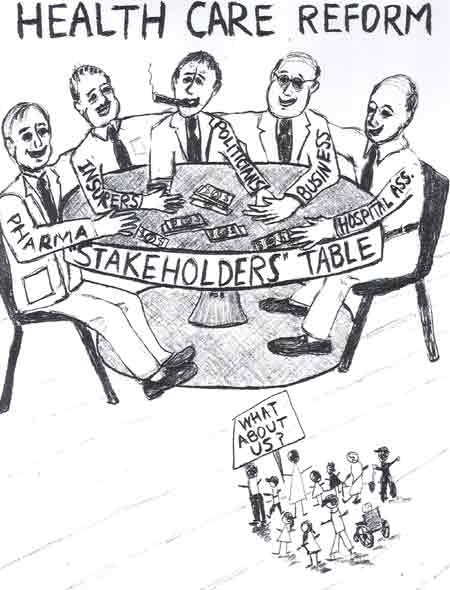 President Obama and Obamacare:
President Obama and Obamacare:
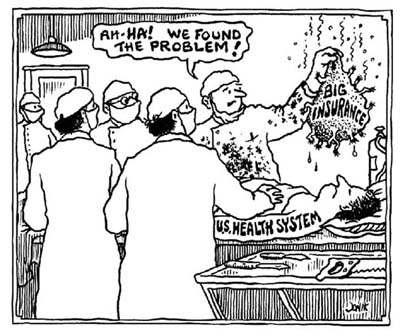 To begin with Obamacare appears to be identifying the problem as an health insurance crisis
and not as a health-medical care system crisis. Too many
are uninsured or under-insured leading to massive unnecessary death and poverty.
It is on this basis that the government is acting since the private insurance industry
has failed miserably to either cover all or put the brakes on increasing costs.
Interestingly enough when HMOs were created in the 1970s this is what they pledged to do. It has not happened.
To begin with Obamacare appears to be identifying the problem as an health insurance crisis
and not as a health-medical care system crisis. Too many
are uninsured or under-insured leading to massive unnecessary death and poverty.
It is on this basis that the government is acting since the private insurance industry
has failed miserably to either cover all or put the brakes on increasing costs.
Interestingly enough when HMOs were created in the 1970s this is what they pledged to do. It has not happened.


 Politicians try to set the role of government and free medical care market enterprise with all
sorts of regulations and barriers in attempts to create an equal paying field
and how free medical care market should function.
And so it is with the medical care system that the government initially legislated over 100 years ago.
Politicians try to set the role of government and free medical care market enterprise with all
sorts of regulations and barriers in attempts to create an equal paying field
and how free medical care market should function.
And so it is with the medical care system that the government initially legislated over 100 years ago. 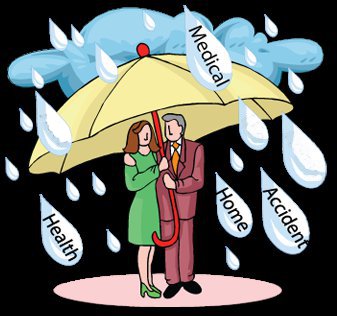






 We need the government [ NIH, CDC, FDA ] to focus on where the largest amount of health care money is spend in the shortest period of time on people. This would be on the terminally ill. Public health measures like improved sanitation and
housing, better nutrition and safer drinking water have eradicated many communicable diseases and allowed all of us to live longer. Living longer brings us face to face with the diseases of age. It isn't lifestyle changes and drugs
that are keeping senior citizens alive – it is machines and doctors doing a lot of the heavy lifting in order to grant us those
precious extra days. These extra few months of extended life are very, very expensive. We need more and better research on how to help terminal elderly live out their lives in dignity. We need to change our perceptions about how and where to die. And yes, we need to fix how we all deal with "end of life!"Obamacare does not do this!
We need the government [ NIH, CDC, FDA ] to focus on where the largest amount of health care money is spend in the shortest period of time on people. This would be on the terminally ill. Public health measures like improved sanitation and
housing, better nutrition and safer drinking water have eradicated many communicable diseases and allowed all of us to live longer. Living longer brings us face to face with the diseases of age. It isn't lifestyle changes and drugs
that are keeping senior citizens alive – it is machines and doctors doing a lot of the heavy lifting in order to grant us those
precious extra days. These extra few months of extended life are very, very expensive. We need more and better research on how to help terminal elderly live out their lives in dignity. We need to change our perceptions about how and where to die. And yes, we need to fix how we all deal with "end of life!"Obamacare does not do this! The treatment and distribution of water for safe use is one of the greatest achievements of the twentieth century. Before cities began routinely treating drinking water with chlorine
[ starting with Chicago and Jersey City in 1908 ], cholera, typhoid fever, dysentery and hepatitis A killed thousands of U.S. residents annually. Drinking water chlorination and filtration have helped to virtually eliminate these
water borne diseases in the U.S. and other developed countries.
The treatment and distribution of water for safe use is one of the greatest achievements of the twentieth century. Before cities began routinely treating drinking water with chlorine
[ starting with Chicago and Jersey City in 1908 ], cholera, typhoid fever, dysentery and hepatitis A killed thousands of U.S. residents annually. Drinking water chlorination and filtration have helped to virtually eliminate these
water borne diseases in the U.S. and other developed countries. 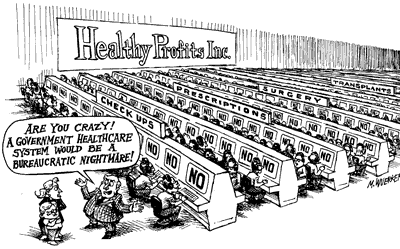
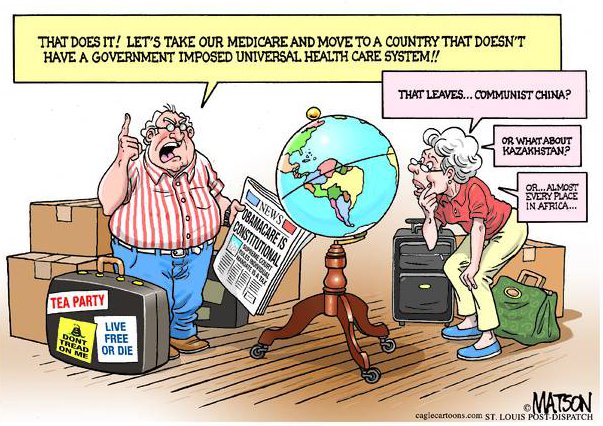
 The nature of the
medical care system aside, the real medical problems are not medical doctors,
medical care providers or hospitals, but instead, the out of control medical -
industrial complex and the behaviors of people ---
their lack of self discipline to exercise and eat properly. Seventy percent of all health expenditures in the United States are devoted to treating chronic disease; only 4% of the
medical care budget is focused on primary prevention.
The nature of the
medical care system aside, the real medical problems are not medical doctors,
medical care providers or hospitals, but instead, the out of control medical -
industrial complex and the behaviors of people ---
their lack of self discipline to exercise and eat properly. Seventy percent of all health expenditures in the United States are devoted to treating chronic disease; only 4% of the
medical care budget is focused on primary prevention.